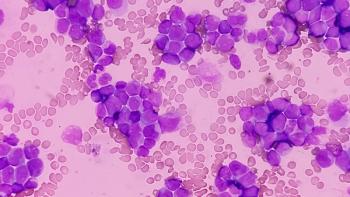
Minimizing Inappropriate Opioid Use in Patients with Blood Cancers

As patients with hematologic cancers live for normal life expectancies, the consequences associated with opioid use becomes more severe.
Prescribing opioids for pain management, while traditionally a common defense against symptom burden, may not be appropriate for patients with certain blood cancers, according to Holly L. Geyser, MD.
Thanks to great advancements in the treatment landscape, survival rates have improved among many hematologic cancers. However, as a result, the risk of overdose, as well as the need to minimize risk of addiction, make other options potentially safer alternatives for certain patients.
Geyser, an addiction expert from the Department of Internal Medicine, Mayo Clinic, recently spoke with CURE®, a sister publication of Oncology Nursing News®, about her research in safely treating pain management in hematologic malignancies with opioid therapy.1
Potential Consequences or Considerations in Opioid Management
Opioids are associated with some harsh consequences that require special consideration when prescribed, said Geyser. Some adverse events (AEs) like constipation, nausea, a little bit of confusion in some populations, and sedation are easier to manage and not so severe. However, opioids pose the risk of overdose, where either the breathing center or respiratory centers shut down, as well as the risk of addiction.
Patients at higher risk for addiction include those with preexisting chemicals dependencies to alcohol, tobacco, or other drugs of abuse. The usual age range of addiction is 18 years to 45 years, and researchers have observed that addiction is slightly more prevalent in males, said Geyser.
In addition, patients with psychological disorders, depression, anxiety, bipolar, schizophrenia, PTSD, history of personal sexual abuse, or trauma, all have an elevated risk of addiction and therefore require additional screening before being prescribed opioids for pain management. “This does not necessarily mean we should not give these patients opioids,” she explained, “It's just a warning sign that these people may need to be monitored more closely.”
Furthermore, literature has demonstrated that patients with cancer are also often at a higher risk for addiction than the average population.
When Are Opioids Considered Inappropriate?
Patients with hematologic cancers experience significant symptom burden, yet this population also often lives longer than the average 5-year prognosis that tends to be associated with patients with solid tumor cancers.
ASCO guidelines currently state that patients should be screened for pain at every encounter. For patients with complex needs, the inclusion of other health professionals should be considered. If patients have not responded to conservative pain management and report symptom burden that impairs function or causes distress, clinicians may prescribe a trial of opioids, monitoring closely for AEs. In addition, clinicians must be fluent in concepts such as tolerance, dependence, abuse, and addiction as they relate to opioids use, and should utilize universal precautions to mitigate abuse, addiction, and adverse consequences. 2
However, these ASCO guidelines, last updated in 2016, are geared towards a heterogeneous group of patients with cancer, and do not specify how to treat hematologic malignancies, Geyser explained.
She cited myeloproliferative neoplasms as an example of a cancer where patients can reach a normal life expectancy, but often report high symptom burden, “Oftentimes, opioids are first-line therapy for these people, [but] 20 years of that is going to buy you consequences.”
With patients whose treatment strategies allow them to live beyond their cancer, providers need to start asking the following questions:
- Is it appropriate to continue these people on unregulated opioid use?
- Could they develop secondary consequences from the opioid usage that will need to be addressed?
- Could these consequences become potentially more harmful than the original cancer itself?
What Are the Alternatives to Opioids?
Unless the cancer is immediately life threatening, first-line approaches should be composed of non-pharmacologic therapy in conjunction with pharmacologic therapy, advised Geyser. Non-pharmacologic therapies can include physical and occupational therapy, as well as Tai Chi and acupuncture. Science has offered great evidence that these alternative therapies are effective at alleviating pain, particularly when they are offered alongside non-opioid drugs such as Tylenol and ibuprofen.
Other alternatives for patients whose mechanism of pain are unlikely to respond to opioids include gabapentin and interventional therapies that can target the nerves themselves. Placing analgesics and steroids into many joints or other spaces within the body can help provide significant relief without risk of addiction of overdose. These services are usually performed by pain management specialist, so Geyser recommends including these specialists as part of the team.
Opioid therapy becomes appropriate when the pain is moderate to severe, or when it appears to become symptomatic. Opioid therapy initiated at a low dose and slowly increased can be fairly safe so long as patients receive consistent monitoring.
What Is the Role of the Oncology Nurse?
Geyser explained that she participated in a study that assessed the number of conversations physicians held with their patients about opioid uses and concerns. They found that the percentage was very low, between 20% to 30%, respectively. The study indicated that physicians have very busy schedules and don’t often find the time to focus on these types of conversations. This is where the oncology nurse can truly have an impact.
Engaged nursing staff represent the first and frontline discussion points with patients. For this reason, Geyser strongly encourages nurses to be aware of the general guidelines surroundings opioid use for patients, correct dosages, etc., as well as how to monitor patients on prescribed opioids when they come into the office. Ask: “Are they extremely agitated? Are they angry, or discriminating, or displaying violent, or potentially violent behavior? Are they showing signs and symptoms of opioid [addiction]?”
Geyser concluded that “anything that might suggest taking a closer look at the whole situation is oftentimes done better by nursing staff, in my opinion, than physicians or first-line providers. They are the key to all of this.”
References:
- Geyer HL, Gazelka H, Mesa R. How I treat pain in hematologic malignancies safely with opioid therapy. Blood. 2020 Jun 25;135(26):2354-2364. doi: 10.1182/blood.2019003116. PMID: 32352512.
- Paice, Judith A., et al. "Management of chronic pain in survivors of adult cancers: American Society of Clinical Oncology Clinical Practice Guideline." J Clin Oncol. 2016;34(27): 3325-3345. DOI: 10.1200/JCO.2016.68.5206
Newsletter
Knowledge is power. Don’t miss the most recent breakthroughs in cancer care.
















































































